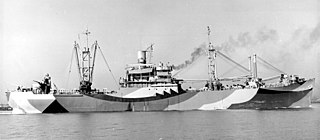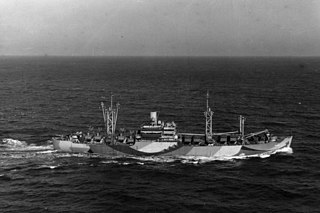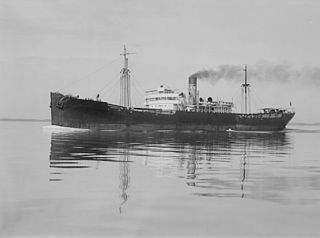
USS Starr (AKA-67) was a Tolland-class attack cargo ship in service with the United States Navy from 1944 to 1946. She was sold into commercial service and scrapped in 1970.

SS Mission San Gabriel was a Type T2-SE-A2 tanker built for the United States Maritime Commission during World War II. After the war she was acquired by the United States Navy as USS Mission San Gabriel (AO-124). Later the tanker transferred to the Military Sea Transportation Service as USNS Mission San Gabriel (T-AO-124). She was a member of the Mission Buenaventura-class oiler and was named for the Mission San Gabriel Arcángel, she was the only U.S. Naval vessel to bear the name.

USS Alamance (AKA-75) was a Tolland-class attack cargo ship in service with the United States Navy from 1944 to 1946. She was sold into commercial service and was scrapped in 1971.

USS Caswell (AKA-72) was a Tolland-class attack cargo ship in service with the United States Navy from 1944 to 1946. She was sold into commercial service and was scrapped in 1973.

USS Duplin (AKA-87) was a Tolland-class attack cargo ship of the United States Navy, in service from 1945 to 1946. She was sold into merchant service in 1946 and finally scrapped in 1971.

USS Stokes (AKA-68) was a Tolland-class attack cargo ship in service with the United States Navy from 1944 to 1946. She was sold into commercial service and scrapped in 1971.

USS Towner (AKA-77) was a Tolland-class attack cargo ship in service with the United States Navy from 1944 to 1946. She was sold into commercial service and was scuttled in 1967.

USS Tyrrell (AKA-80) was a Tolland-class attack cargo ship in service with the United States Navy from 1944 to 1946. She was sold into commercial service and was scrapped in 1967.

USS Vinton was a Tolland-class attack cargo ship in service with the United States Navy from 1945 to 1946. She was sold into commercial service and was scrapped in 1971.

USS General A. W. Greely (AP-141) was a General G. O. Squier-class transport ship named for U.S. Army general Adolphus Greely. She was transferred to the U.S. Army as USAT General A. W. Greeley in 1946. On 1 March 1950 she was transferred to the Military Sea Transportation Service (MSTS) as USNS General A. W. Greely (T-AP-141). She was later sold and converted to a container ship and operated under several names before being scrapped in 1986.

The TS Golden Bear is the training ship of the California State University Maritime Academy (CSUMA), a campus of the California State University. The first training ship of the then–California Nautical School was known as the Training Ship California State, then as the T.S. Golden State. Since then, there have been three ships to bear the name T.S. Golden Bear.

USS Guilford (APA-112) was a Bayfield-class attack transport in service with the United States Navy from 1945 to 1946. She was sold into commercial service in 1947 and was scrapped in 1976.

USS George F. Elliott (AP-105) was a cargo liner built for the Mississippi Shipping Company as SS Delbrasil for operation between New Orleans and the east coast of South America in 1939 by its operator, Delta Line. The ship entered that service and operated until taken over by the War Shipping Administration (WSA) on 28 April 1942 for operation by Delta Line acting as WSA's agent. On 25 August 1943 WSA allocated the ship to the Navy for conversion to a troop transport commissioned and operated by the Navy for the duration of the war. Ownership of the ship was transferred from Mississippi Shipping to WSA on 4 February 1944 while under Navy operation and was retained until sale to American South African Lines on 22 December 1948. The ship was renamed African Endeavor until returned as a trade in to the Maritime Commission on 22 September 1960 for layup in the James River reserve fleet and later sold to Boston Metals for scrapping.

The Type C4-class ship were the largest cargo ships built by the United States Maritime Commission (MARCOM) during World War II. The design was originally developed for the American-Hawaiian Lines in 1941, but in late 1941 the plans were taken over by the MARCOM.

SS West Elcajon was a steel-hulled cargo ship built in 1918 for the United States Shipping Board's World War I emergency wartime shipbuilding program.
The Type C7 ship(Lancer Class) is a United States Maritime Administration (MARAD) designation for a cargo ship and the first US purpose-built container ship. The vessels were constructed in US shipyards and entered service starting in 1968. As US-built ships they were Jones Act qualified for shipments between US domestic ports. Under the Jones Act, domestic US maritime trade is restricted to US-built and flagged vessels of US owners and manned by predominantly US-citizen crews. The last active Lancer container-configured ship was scrapped in 2019. Lancers of the vehicle Roll-on/Roll-off (RO/RO) configuration remain held in the Ready Reserve Force, National Defense Reserve Fleet and the US Navy Military Sealift Command. All are steam powered.

The SS Bluefield Victory was the 16th Victory ship built during World War II under the Emergency Shipbuilding program. She was launched by the California Shipbuilding Company on May 9, 1944, and completed on June 30, 1944. The ship’s United States Maritime Commission designation was VC2- S- AP3, hull number 15 (V-15). SS Bluefield Victory served in the Pacific Ocean during World War II and was operated by the Mississippi Shipping Company. The 10,500-ton Victory ships were designed to replace the earlier Liberty Ships. Liberty ships were designed to be used just for World War II. Victory ships were designed to last longer and serve the US Navy after the war. The Victory ship differed from a Liberty ship in that they were: faster, longer and wider, taller, had a thinner stack set farther toward the superstructure, and had a long raised forecastle.

The Type R ship is a United States Maritime Administration (MARAD) designation for World War II refrigerated cargo ship, also called a reefer ship. The R type ship was used in World War II, Korean War, Vietnam War and the Cold War. Type R ships were used to transport perishable commodities which require temperature-controlled transportation, such as fruit, meat, fish, vegetables, dairy products and other foods. The US Maritime Commission ordered 41 new refrigerated ships for the US Navy. Because of the difficulty of building refrigerated ships only two were delivered in 1944, and just 26 were delivered in 1945 and the remainder in 1946–48. The 41 R type ships were built in four groups. Two of design types were modified type C1 ships and two were modified type C2 ships. The United Fruit Company operated many of the R type ships in World War II. The type R2-S-BV1 became the US Navy Alstede-class stores ship and the type R1-M-AV3 became the US Navy Adria-class stores ship.

SS India Victory was a Victory ship built and operated as a cargo carrier and troopship in World War II. After the war the ship was used a private cargo ship. She sank on 12 July 1972, ran aground on a Pratas Reef in the South China in Typhoon Susan.
Pacific Far East Line, also called PFEL in short, was a passenger and cargo shipping line founded in 1943 by Thomas E. Cuffe, in San Francisco, California. At the beginning he started by chartering foreign ships to run the lines in tramp trade. Later scheduled cargo services were added to the line. During World War II the South Atlantic steamship line was active with charter shipping with the Maritime Commission and War Shipping Administration.
This page is based on this
Wikipedia article Text is available under the
CC BY-SA 4.0 license; additional terms may apply.
Images, videos and audio are available under their respective licenses.
















